Where: Riga and Sigulda in Latvia
When: February 2013
Why? Jeff and I went to Latvia on our Baltic backpacking trip. We started in Lithuania, then we went to Latvia before ending in Tallinn in Estonia. We spent five days in Latvia.
Whilst in Latvia we were based in Riga and we took a day trip out to Sigulda: the ‘Little Switzerland’ of Latvia.
>->->->->->->->->->->->->->->->
Map
>->->->->->->->->->->->->->->->
Intro
I think out of everywhere we were going in the Baltics, I was most excited about Riga. People rave about Riga! I had heard that it is an amazing city, with some of the best nightlife in northern Europe (which is why all of the stag parties go there). I had also heard that there is loads to see and do, and as it used to be one of the largest, most important cities in the world, I thought that there would be loads of amazing treasures to visit and wondrous things to see.
Riga is very nice. It is a lovely medieval city. There are some beautiful buildings to see, and some great bars to drink in and yet… and yet it didn’t quite live up to our expectations. I liked Riga, but I can’t understand why people rave about it so. In fact, compared to its sister city of Tallinn, I think Tallinn is much cooler and much more interesting.
However, I don’t wish to denigrate Riga too much, as it is a great city. In fact, thinking back, I can’t understand why I’m not raving about it – but whatever magic other people have found there – we didn’t. It is a nice place, and would probably be a great city to live in – but as a tourist, we felt that two days was more than enough time to experience the city.
Riga is a city of stately buildings, beautiful churches, great parks for wandering in etc. It has an interesting Hanseatic, historical heart, an elegant art-deco area, some funky modern new builds, and lots and lots of bars and restaurants. It is a great city, and though I’m not raving about it, I did really like it and we had a great time there.
The rest of Latvia looks very much like Lithuania and Estonia, with flat, forested landscapes. We had an interesting day out in the pretty resort of Sigulda where we explored four castles and saw the largest cave in the Baltic States (it’s not very big but it’s really interesting).
Latvia was a good value place to visit (£2 for a bottle of Russian champagne!), which is perhaps why it attracts the stag parties.
Maybe if I had drunk more of the £2 bottles of champagne I would be raving about Riga. Instead I will just say that it is a thoroughly nice city and a good place to spend a few days.
>->->->->->->->->->->->->->->->
Getting there
We travelled to Riga from Siauliai in Lithuania, which is where the Hill of Crosses is located. We caught a bus from the bus station in Siauliai and it cost us 40LT (about £10). The bus we caught was a mini-bus and we had to pay for our tickets on the bus, rather than buy a ticket from the ticket desk. It took about two hours to get to Riga, dropping us off at the central bus station.
The central bus station is located next to the train station and the huge zeppelin hangars of the central market.
Just a quick note about Riga bus station: someone tried to pick pocket me here, when we were boarding the bus for Tallinn. This man had been acting very strangely and pushed into the queue in front of some other passengers – so we all noticed him. He then got rather too close to me as I was boarding the bus, and when I turned around to reprimand him, I saw he had my phone in his hand – taken out of my coat pocket. I grabbed it and said in my best teacher’s voice ‘why is my phone in your hand’ – and then turned around to talk to the driver. After that – he ran off. So anyway – just be careful and keep an eye on your bits and bobs.
>->->->->->->->->->->->->->->->
Getting about
In Riga
Riga has a great public transport system with trams, buses etc. There was a great map at the bus station explaining clearly how to navigate the system. However, we didn’t use public transport as the centre was compact and we walked everywhere.
You can find out more at www.rigassatiksme.lv.
Getting to and from Sigulda
To get to Sigulda we caught a bus from Riga central bus station. The bus ticket cost us 1.50Lv each (about £1.80). The bus journey took about an hour and a half. There was great wi-fi and a toilet on board the bus.
The bus station in Sigulda is located next to the bright orange train station.
Within the Sigulda area we walked to Turaida and then we caught Bus 12 from Turaida back to the bright orange train station. It cost us 60 cents (70p) and took 15 minutes to get back to our start point.
Coming back to Riga, we caught the train (see above) from Sigula’s bright orange railway station to Riga Pasazieru. It cost 1.65Lv (£2) each and the journey took about an hour and a half. The journey time was the same as the bus, and I think that if I had the choice, I would choose the bus over the train, as the journey back was very dark, cold and boring – and the bus was warm and has wi-fi.
>->->->->->->->->->->->->->->->
What we did on our holiday
Riga old town
We spent our first day just wandering around the old city of Riga, and it took us a full day to see most of the key sites. The old city is a very accessible, atmospheric, medieval city – with lots of churches, ornate buildings, museums, modern shops, bars and restaurants. It must be great pre-Christmas with all of the Christmas markets. It’s a very pretty, atmospheric and touristy place.
We started our explore by the Freedom Monument and the Russian Orthodox Cathedral/Church of the Nativity. The Church of the Nativity is a beautiful domed building, that is made of this gorgeous, gold stone that seemed to glow in the winter sunlight. It was so pretty and attractive and inviting. It made me smile.
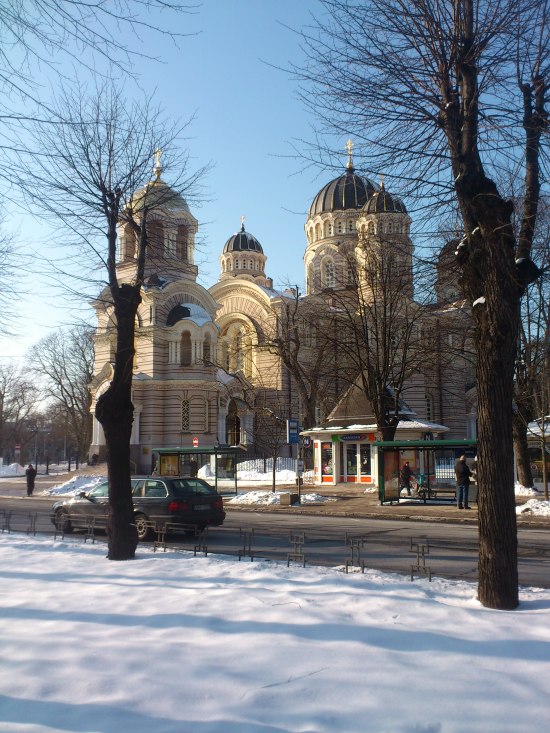
Just past the Church of the Nativity is the Freedom Monument. This is a column monument, guarded by two soldiers. It sits in the middle of the large pedestrianised road on the way into the old city. It is a good meeting point. That is all. Another good meeting point is the brown clock, just past the monument – which was sponsored by a chocolate company. This clock is located at the entrance to the old city. Many Rigans use this as their meeting point for the old town.
Running around the outside of the old city, where the walls and the moat would have been, is a beautiful park. When we were there there were lots of ducks quacking about and people sledging down the small hills on their bums and having snow ball fights. It was a nice space around the city and a good place for a stroll.
We entered the old town by Freedom Monument and walked through a series of squares towards the centre of the city. We passed many nice restaurants, musicians, and interesting shops and stalls. We found one square with a beautiful hanging, mirrored sculpture, reflecting the sparkling winter sunshine and the fabulous façades around us.
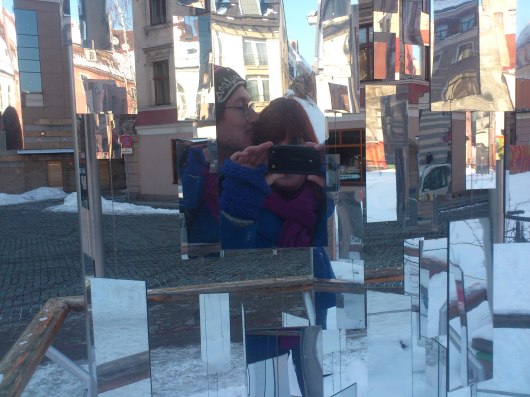
We made our way down to Town Square, which is where the Town Hall and the House of the Blackheads are (see top of the page). This is also where the Christmas Tree was apparently invented. The House of the Blackheads was the guildhouse for the bachelor merchants of the Hanseatic League. The house didn’t get its name because of the youth’s pimply skin, but because their patron saint is St Mauritius, who had a black head. Anyway, apparently one Christmas Eve, the blackheads got into some high jinks and set a huge pine tree on fire – and this is why we have Christmas Trees to this day.
The House of the Blackheads building is very pretty and ornate and has great paintings on the outside. Another great building, which I think is next door, is Mentzendorff’s House.
Also in the Town Hall Square is the Museum of Occupation in Latvia. This was the only museum that we fancied seeing in Riga, as we wanted to learn more about Latvia’s history under the Nazis and the Soviets, but sadly it was closed for refurbishment when we were there. They did however have an interesting and moving display outside of the museum which gave information about Latvia’s history, focusing specifically on the time of occupation. It told what happened to people in the country under occupation and how so many of them died or were sent to concentration camps. What is so heart breaking is that soon after Latvia gained independence they were overtaken by Nazi Germany, who sent most of the country’s Jews to the concentration camps of Poland. The country was ‘freed’ by the Soviets but then the people were punished for ‘collaborating’ with the Nazis. This time, rather than being sent to camps in Poland, people were sent to camps in Siberia or were forcibly moved to other parts of the Soviet Union.
Latvia has a very sad, unfair history.
We spent about 15 minutes reading the display boards and if these are any indication of the museum, then I think the museum must be very interesting and moving.
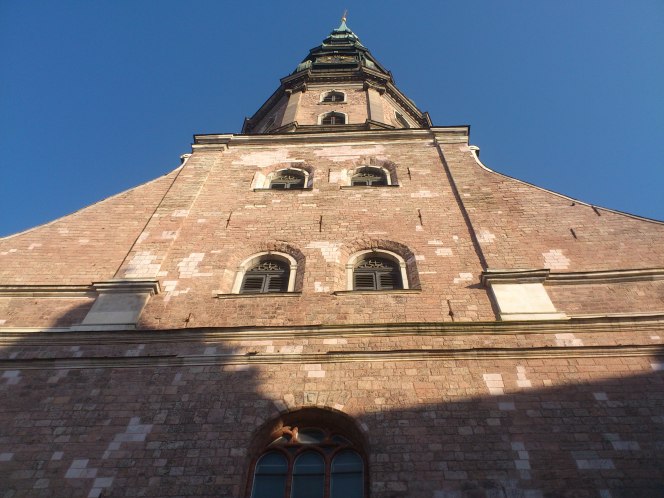
St Peter’s Lutheran Church is the tallest church in Riga. You can go up the steeple in a lift for great views over the city, but it cost 5Tl each (about £6), so we decided to look at photos taken from the top of the tower instead and to save our pennies.
We wandered from St Peter’s Church, over to the Dome Cathedral, down some pretty medieval streets and past the gorgeous three brothers, medieval houses with lovely, coloured façades.
The Dome Cathedral is the largest church in the Baltics and it contains the oldest museum and the 4th largest organ in the world (it used to be the largest). We thought that as the Dome was the cathedral for the city, a city which used to be one of the most important cities in the world for trade, that it would be really impressive. We even paid 2TL (about £2.50) to go in. It wasn’t worth it. Partly because it was being restored and so there was lots of scaffolding inside, but also because it was a really plain, boring cathedral. The museum at the back seemed to just be a hodge podge of things, dumped in the cloisters (including some car seats). We wanted our money back.
After visiting the Dome Cathedral, we then went to the yellowy-white castle, which is also the President’s Palace. It’s really low key for a president’s palace, and didn’t look important at all. In fact, it was looking a little bit shabby. We walked around it and alongside the frozen river at the back, and then back into the old medieval town. (We quite enjoyed this walk however as I was telling Jeff the whole plot of the Game of Thrones books – all four of them, and it was cold but sunny and fresh).

The last part of our tour took us down some cobbled streets, through the ancient, medieval Swedish Gate (it’s quite low – see above) and then we walked alongside the old walls to the old Powder Tower – past lots of interesting cafes and shops.
It took us a full day to explore the old town (with cafe stops etc.) and we had a really nice time. Riga old city is a lovely, very pretty, atmospheric place to be. It would be a lovely place to live in too.
Central market
The central market is located next to the bus and train station. It is a very distinctive market as it is located in five huge Zeppelin hangers. The market is kinda cool to potter around – and if I lived in the city I would probably buy my food here as they had some pretty nice stuff. It was interesting for a little while to potter about, but as we were both really restricted on our budget and luggage allowance, we didn’t actually buy anything.
Art nouveau walking tour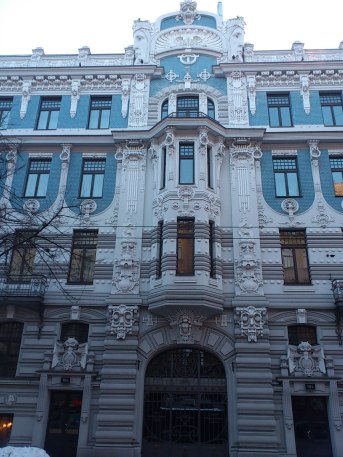
There are 750 art nouveau buildings in Riga and the Lonely Planet had a great short walking tour around some of the best – so we followed this. Most of the buildings are on 3 streets: Elisabetes iela, Strelnieku iela and Albeta iela.
Now, art nouveau buildings are not something that J or I would normally go hunt out. If we saw them, we’d go ‘oh, that’s cool’ – but we wouldn’t go look for them. However, we had a spare few hours and we thought it would be a good way to see another part of the city. And I’m so glad we went to see them as the buildings are brilliant! Some of them are covered in screaming Valkyrie, naked gods and goddesses, nymphs, laughing crazy people, animals, flowers, women with ships on their heads.
The statues are funny and interesting and slightly crazy – and really, really cool. The building with the screaming women on, we didn’t actually notice them at first as they were carved so well and such a part of the fabric of the building – but they are huge!
This area of the city is the embassy area and there are some nice cafes and a nice park. It was only about 15 minutes away from Freedom Monument and we had a nice time strolling in a different part of the city.
Sigulda
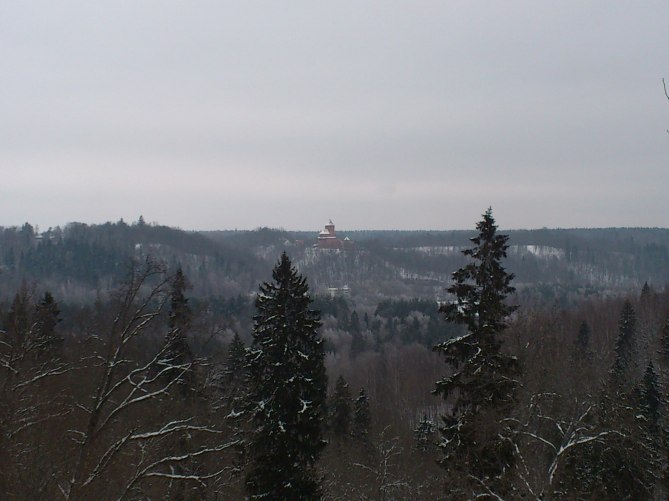
Sigulda is a town located on both sides of the Gauja River, about 50km from Riga. It is in a nature reserve to the east of the city. They call it Little Switzerland, and I have no idea why as apart from the river valley, it’s pretty flat. They do have a bob-sleigh there though, so maybe this is why.
We went to Sigulda as we had heard good things about it, because we wanted to see more of Latvia than just Riga, and because our guidebook (‘The Lonely Planet guide to the Baltics’) included an interesting walk which took in four castles, a cave and a cable car. We were also kind of attracted by the possibility of going on the bob-sleigh. Those things are cool!
So we caught a bus to Sigulda, and we were dropped off by the bright-orange train station.
We walked from the bright orange station to the old castle and the new castle, which should have just taken us ten minutes, but as we got lost and took a diversion through a 20 foot snow drift, up a steep hill and past a nuclear bunker (or a boiler room) it actually took us about 30 minutes to get there. Basically, if you walk from the station, don’t follow the road (Reina iela) downhill – follow the track, past the pretty, white Lutheran church on the right.
Sigulda New Castle was built in 1878 by Prince Kropotkin. At one time it was a psychiatric hospital, but now it is the offices of Sigulda Regional Council. There’s nothing to see at the castle. We just walked through the grounds on the way to the medieval castle, but it’s interesting to see where a prince once lived. (It seemed a bit of a small castle for a prince, if you ask me).
The medieval castle, which is at the back of the new castle, was built in 1207 by the Order of the Brethren of the Sword (how cool do they sound?). The castle until a few years ago was just a medieval ruin of a series of walls, but in the last year or so they have partially rebuilt the castle and so now you can go up into the ramparts, climb the towers etc.
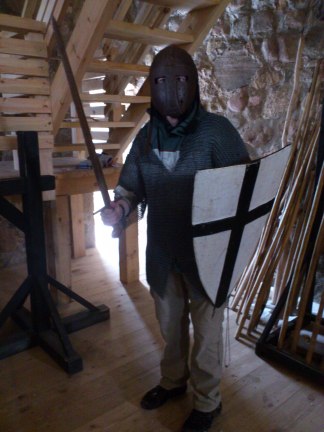
We were the only people at the castle (well, it was mid-week in the middle of February), and so the knight who guards the castle offered to give us a guided tour (we think he wanted to sneak off for a smoke too). He was great! His English was brilliant, he was really knowledgeable and very funny. He took us to ‘his office’ in the tower where there were loads of weapons to play with and where we could try on the armour. It was a lot of fun.
There were great views from the medieval castle – we could look ahead, over the valley, to the castles and caves we were going to walk past. We climbed a tower at the far side of the site and the views from here were amazing.
They also had a huge, outdoor concert area at the castle and I think in summer they hold many plays and concerts here, though not in Feb as you’d get a bit of a cold, wet bum.
The visit to the castle only cost us 1Lati each (£1.20) and we spent about an hour there.
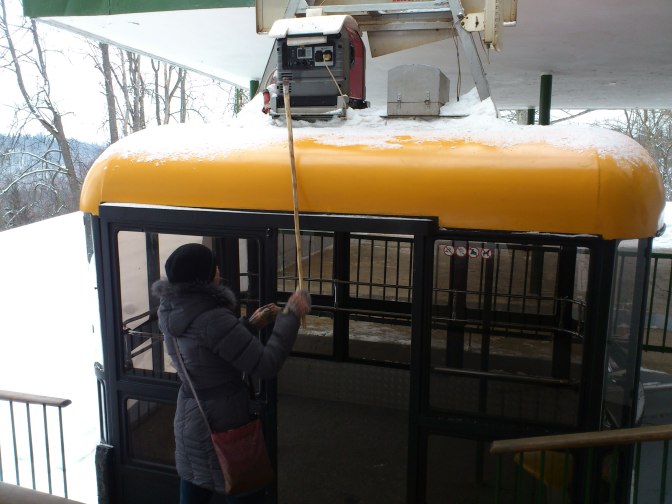
After visiting the medieval castle, we walked across the hill top to the edge of the river valley, to the Sigulda Cable Car (Sigula Trosu Cels). We didn’t think the cable car was in operation when we walked up, as there seemed to be no one there, but the lady who ran the cable car switched it on just for us (using a big stick), she put a little fan heater in to warm it up, and then for 2lita (£2.50) she took us across the river.
It was fun, but it seemed to putter along quite slowly. This is the only cable car in the Baltics, and as I said to Jeff, I did wonder where the nearest cable car mechanic was, in case we had any problems. About half way across there was a huge teddy bear in the top of a tree.
In summer, they do bungee jumps out of this cable car, over the Gajura River. For more information visit www.lgk.lv or www.bungee.lv. In winter, the cable car runs every half an hour. It costs 2Lati (about £2.50) for one way, 2.5Lati (£3) for a return trip.
The cable car dropped us off outside our third castle of the day, Krimulda medieval castle. Little remains of the castle and it hasn’t been rebuilt since the great Northern War, so it just seemed to be a series of walls on the hill top, defended by a really annoying, small, yappy dog. We didn’t go up close, we just wandered past it and down the tracks to the river valley.
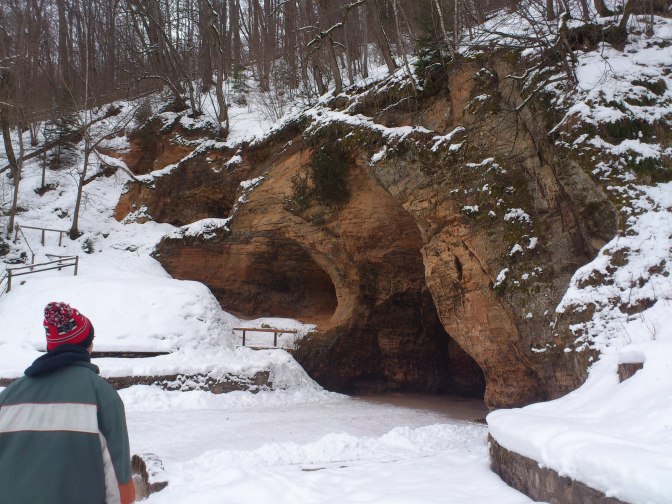
Once in the valley, we walked along the road for a small way before coming to Gutmana Cave, which is the largest cave in the Baltics and Latvia’s oldest tourist attraction. There is a story attached to Gutmana Cave. Apparently, an adopted daughter of a local lord fell in love with the head gardener. A nasty knight fell in love with the girl and enticed her away from the castle to the cave, by pretending to be her love. When she got to the cave, the knight tried to kidnap her. The ‘Rose’ told him that she had a magic scarf that could make the wearer immune to injury. She persuaded him to test it on her, thus he cut off her head and she retained her honour (but lost her head – doh!).
The story is apparently true, as you can see the grave of the Rose of Turaida at Turaida Castle.
The cave is really interesting, not for the story, but because of the carvings on the walls. As caves go, it’s not particularly big – it’s more of a large gash in the hillside with a spring coming out – but every inch of wall is covered in carved shields and carvings of people’s names – going right back to the 16th century. It’s really fun to try to find the oldest carvings, and it’s interesting to think what country the cave was in, when the carving was made – as Latvia has changed hands so many times.
The cave is located in a large, streamy, open field – which was just a wet, snowy expanse the day we were there. It was really cold, but luckily on the other side of the road, under an underpass – there was a visitor centre which was open, and which had a hot tea machine and toilets. We spent about fifteen minutes here warming up and talking to the girl manning the information desk. Visiting the cave is free.
Once we had warmed up we walked up the road, up our final hill, to the Turaida Museum Reserve. This was our final castle for the day. Turaida Castle is a red, 13th century castle. We climbed Donjon Tower for some great views over the surrounding park, and back over the way we had come. We also had a look in some of the castle buildings where there was a really informative museum about the castle and its history. It was quite interesting, although we didn’t give it as much attention as it deserved as by this time we were castled out – and it contained a lot of information.
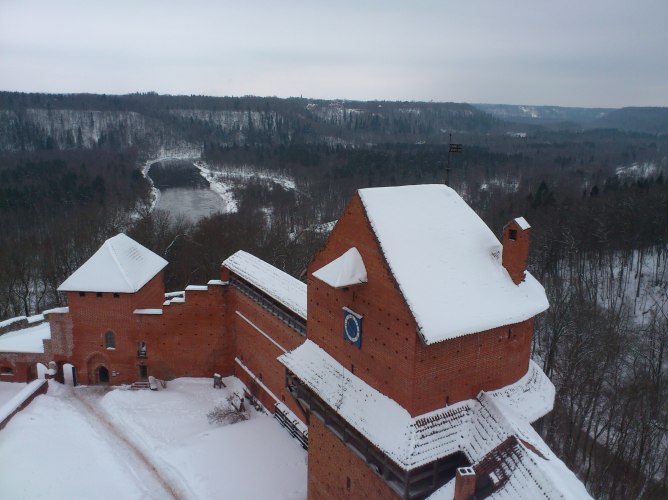
The castle is located in a big park, where there are many other traditional houses and also a sculpture park. The castle is known as God’s garden, because it has stunning gardens – but in February, they were all covered in snow so we didn’t see these. www.turaida-muzejs.lv. 2Lati (about £2.50).
Finally, we caught bus 12 back to our start point at the bright orange station and then a train back to Riga.
The walk is only about 6 km, but with all the things to see and the snow, it took us a few hours to do.
For more information on Sigulda, visit www.tourism.sigulda.lv.
What initially drew us to Sigulda was the bob sled and luge track. These are professional tracks where the Olympic team trains. You can have a go, however they are only open Saturday and Sunday, 12 noon to 5pm, which is why we did not get to go. For more information, visit www.bobtrase.lv.
>->->->->->->->->->->->->->->->
Where we ate and drank
Maxima
So, as we were on a budget, and champagne was £2.50 a bottle, we had a couple of bed-niks in Riga. There was a Maxima supermarket at the station and we went in here to buy provisions (and cheap champagne). There were a few Maxima supermarkets around the station.
XL Pelmeni
Pelmeni XL is a great dumpling shop in the heart of Riga old city, and it is a great, budget place to eat (and drink). It is open till late, so apparently many Rigan boozers stop here on the way home from the pub. Pelemi XL serve lots of different types of dumpling/perogis – with meat, cheese and vegetable fillings, and you could have them dry or in a broth. You could also have lots of different toppings on them – including coriander, cheese, bacon fat etc. They then weigh the dumplings and you pay by weight. The food is good, cheap and hearty – and will put fat on your bones. They also sold pretty cheap drinks, including nice fruity ciders. www.xlpelmeni.lv.
Lido
Lido is a chain of restaurants that sell good basic lunches for low prices. They’re a bit canteen like, but the food is pretty nice. For salads and stuff, they charge you by weight. They also serve basic Baltic meals – hearty meat and veg dishes, deserts and cheap wine. The food is okay and the restaurants are nice – and cheap. www.lido.lv.
Golden Coffee Club
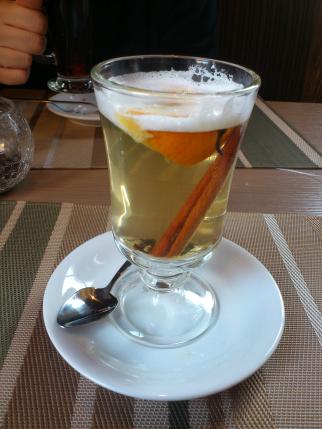
Golden Coffee Club is located in between the House of the Blackheads and St Peter’s Basilica. We normally wouldn’t have gone into a restaurant so close to the tourist attractions, as prices can be a little bit steep – but as they offered a cheap set menu – we decided to pop into Golden Coffee Club – and then we liked it so much, we went back the next day.
The food was basic but good (I think I had lasagne and it was okay) – but what bought us back was the amazing drinks menu. I had a white mulled wine – which was just yummy! It was a heart-warming, honeyish, fruity drink that seemed to flow straight into my veins. (Just look at it on the right – couldn’t you just drink that right now?) Jeff had an interesting Black Balsam cocktail – which didn’t taste disgusting (and if you have tried Black Balsam, you would know that is quite an achievement). Black Balsam is the local booze of Riga – more about this below.
They also offered interesting tea cocktails (non-alcoholic), a hot chocolate menu – with about 10 choices and a great coffee menu too. And price wise, it wasn’t too bad.
Golden Coffee Club is on Kuala Iela (Gentleman’s Street). www.goldencoffee.lv.
Fontaine Delisnack Riga
Our hotel had one of those rotating things with special offer coupons attached to it, and one of the tokens offered a 10% discount at Fontaine Delisnack, which was a burger and booze house – so we went here for some cheap food.
When we got there, we found that it was actually a rock bar (which took me straight back to my youth) – and so we had interesting burgers, chips and pints of cider (which also took me straight back to my youth).
The burger bar was located on the edge of the old town and it was a pretty cool place to be and quite cheap. It’s also open 24 hours in case you fancy a late night snack on the way home. www.fontaineriga.lv.
Coffee Inn
Coffee Inn is a chain of coffee shops that we visited across the Baltics. They serve cheap good coffee, big fluffy sofas and free wifi. In Riga, we went in here to warm up when the cold started to physically hurt. That is all. www.coffee-inn.lt.
Skyline bar and KHL (ice hockey) sports bar
The skyline bar is on top of the Radisson Blu hotel, overlooking the Freedom Monument, the medieval city and Esplanade Park. Apparently it is amazing for sunset cocktails, but – you have to pay 2Lt just to go in (about £2.50), so we decided not to bother.
At the other end of the hotel, down in the basement, is the KHL sports bar, which is dedicated to ice hockey – so I had to take my Canadian boyfriend here. As it’s in a basement, it is a very dark bar – but they have screens showing sports everywhere and tables in fake goals etc. I’m sure for a bunch of lads it is great, but as I was the only girl and they were just showing soccer, I didn’t feel that comfortable and so we decided to find somewhere else.
www.skylinebar.lv and www.khlsportsbar.com.
Black Magic Bar (the home of Black Balsam)
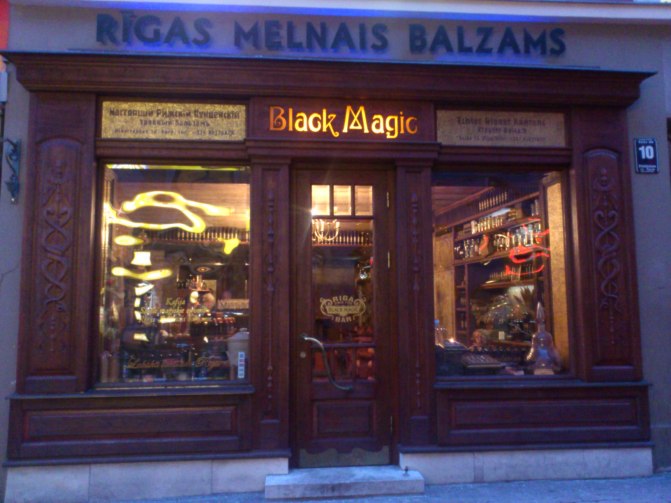
Opposite XL Pelmeni is the Black Balsam shop, where the Rigan local booze, Black Balsam, was invented. Like most local boozes, the Rigans claim it has amazing health benefits. Sadly, also like most local boozes, it is absolutely disgusting and it’s probably local because no one else wants to drink it. Black Balsam is really bitter and dark and treacley. You can get it in regular and current flavour.
Black Balsam was invented in an apothecary in the centre of the old town and this is still there, still with its traditional design. It’s very pretty, with the olde decorations and the roaring log fire, but being a touristy place, it’s also very expensive – so we just popped in for a look and then left again.
They sell all sorts of things with Black Balsam in, such as chocolate and drinks etc, but if you want some to take home – it’s much cheaper to buy in the supermarket. www.since1752.lv.
The Victory Pub (I think)
I can’t remember why we chose the Victory Pub out of all the amazing pubs in Riga. I seem to remember it just looked really inviting from outside. It was a cosy pub with bright red walls, cheap wine and beer and a good atmosphere. We liked it.
The only thing that annoyed me about the Victory Pub was the Brits. We met a group of guys on a stag do and although they were all pretty friendly, their ignorance of Latvia was kind of annoying. One of them (to be fair he was very drunk) didn’t know that Latvia had been a part of the Soviet Union and he kept talking about people (Latvians) really loudly, thinking they couldn’t understand him – when most of the Latvians in there probably spoke better English than him.
However, they were very friendly to everyone and I’m sure Riga gets much worse stag groups than these guys…
The Victory Pub is over by the Dome Cathedral. www.victorypub.lv.
Queen’s Public House
This old fashioned English pub is in the centre of the old town. It looks like a fab old place, with an enclosed wooden bar in the centre, black and white tiled floor, bar stools galore and wide screen TV. We went in here for a quiet pint at the end of the evening and it had a good atmosphere. I’d initially not wanted to try it as it looked quite busy, and I thought that it would be full of stag parties – but when we went in we found that it was a really friendly local with lots of English ex-pats holding up the bar. www.queens.lv.
>->->->->->->->->->->->->->->->
Where we stayed
Wellton Gertrude Hotel
I spent ages sat in the corridor of the Magnus Hotel in Kaunus, trying to choose a hotel in Riga. We wanted somewhere good value, but in the old town and I just couldn’t find anything.
In the end, in the five minutes before we boarded the bus I just booked the Gertrude Hotel, which, even though it wasn’t in the old town, looked like a good value, 4 star hotel.
The Gertrude Hotel was the best hotel of out Baltic trip – and great value. We had a wonderful, comfy, ornate room with a huge bath and bedroom. They served great buffet breakfasts – with free champagne.
It wasn’t located in the old city, but the walk to the centre wasn’t too bad – it took us about 15 minutes to walk to Freedom Monument – and it was actually quite nice to have a head-clearing stroll at the end of the night. The area the hotel is in is a little bit run down, but it was quiet and there were one or two good value restaurants and shops nearby.
For four nights accommodation in a four-star hotel, with champagne buffet breakfast included – we paid £112 (that’s £28 per night/ £14 each). It was an absolute bargain.
Red Roofs Inn
My second choice of hotel was the Red Roofs Inn – which was a little bit more expensive that the Gertrude Hotel. If we go back, I might stay here because it is in the old city and Red Roofs is great! It’s more of a hostel than a hotel, but it had five bars, a pool room and was really funkily decorated!
We wandered in by accident, as we were actually following the special offer cards to bars with cheap drink offers -and one of them was at Trattoria del Popolo – the Italian restaurant connected to Red Roofs. They let us have a look around the hostel and it looks like a really cool, fun, friendly place to stay. www.redroofs.lv.
>->->->->->->->->->->->->->->->
Useful links
www.lonelyplanet.com/latvia/riga
www.inyourpocket.com/latvia/riga
Useful site for Sigulda: www.tourism.sigulda.lv.
Disclaimer
Please note, some, if not much of this information may not be correct, or may be out of date. All these articles show is how we found these places when we visited and what we personally thought of each place. Where possible I will include links to site which will contain more up-to-date info. All of this is our own work and any opinion expressed is that of the author only.
All photos copyright of J Clemo-Halpenny. If you would like to copy or reproduce any of these images, please email me to ask permission.

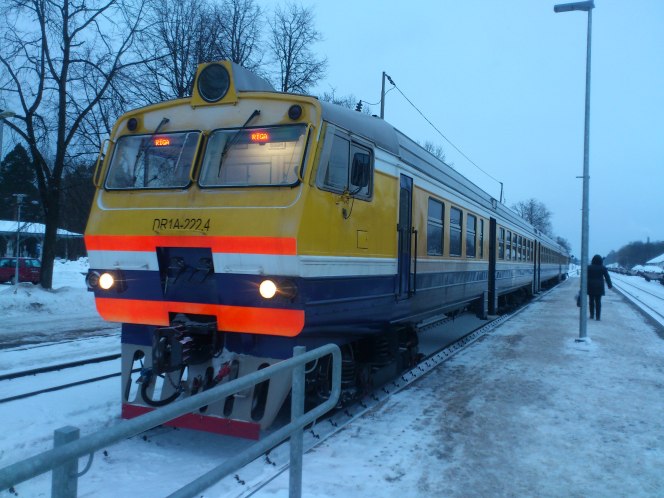
Sigulda really is a nice small town and I really like the nature in the area. We visited last summer and walked from Sigulda to Krimulda and then to Turaida, really amazing views. 🙂
LikeLike